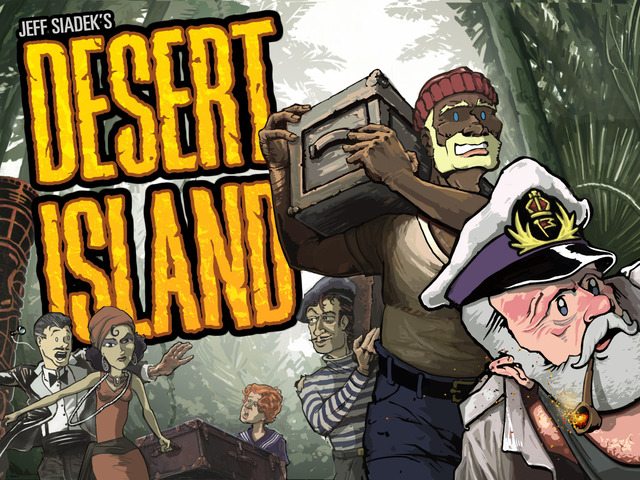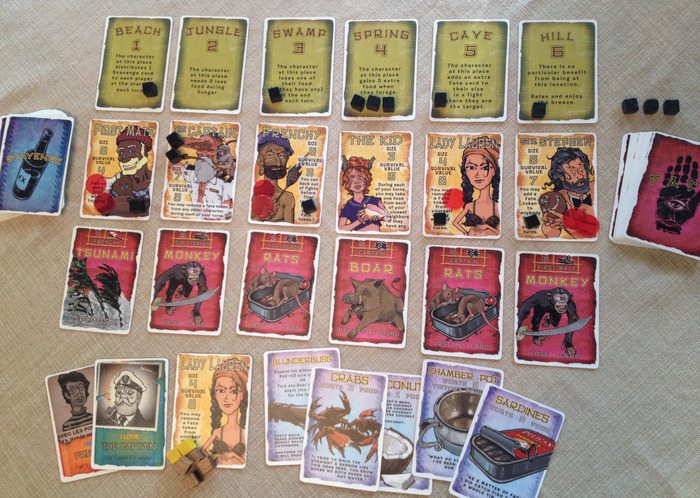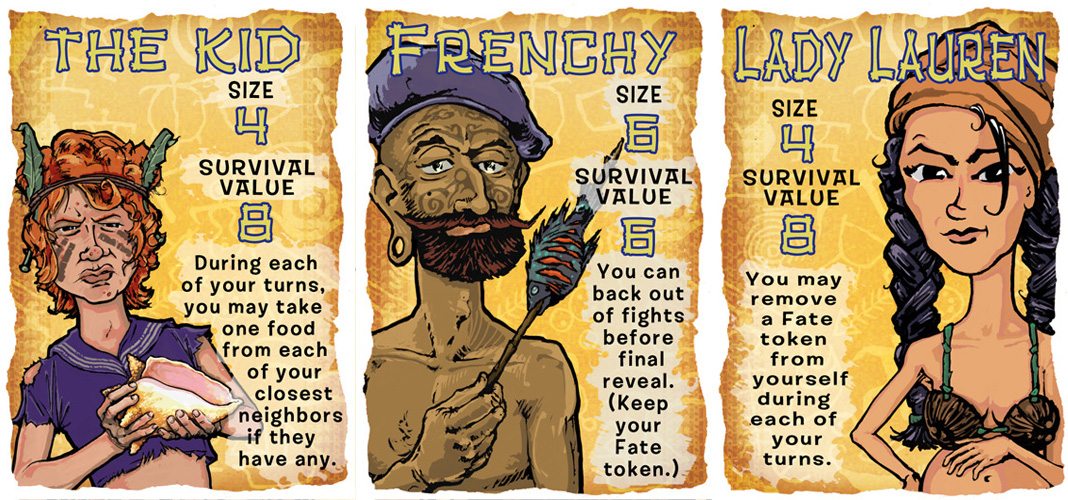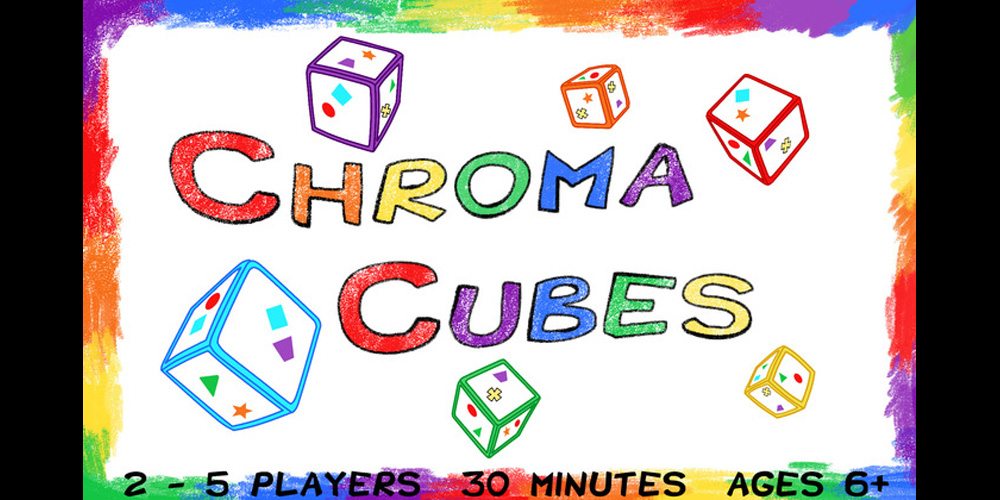 Despite all the fighting and grumbling (and sharks!), your lifeboat finally made it to land. You’re saved! … Or so you thought. As it turns out, you’ve ended up on a Desert Island, filled with rats and tsunamis and nasty diseases. So you work together to survive—up to a point. There’s that one person you could do without…
Despite all the fighting and grumbling (and sharks!), your lifeboat finally made it to land. You’re saved! … Or so you thought. As it turns out, you’ve ended up on a Desert Island, filled with rats and tsunamis and nasty diseases. So you work together to survive—up to a point. There’s that one person you could do without…
At a glance: Desert Island is for 4 to 6 players, ages 13 and up, and takes about an hour to play. It’s on Kickstarter now, and the basic pledge level for a copy of the game is $30. Note that because of the backstabby nature of the game, you want to make sure that you’re playing with people who won’t take things too personally. 13 and up is probably about right, though you know your kids best.
New to Kickstarter? Check out our crowdfunding primer.

Components:
- 1 “Sequence of Play” and “Fighting” player aid card
- 40 brown single-food cubes
- 10 yellow “4” Denomination food cubes
- 20 black Fate cubes
- 6 Character Island Location cards
- 6 Character Player ID cards
- 6 Location cards
- 6 Love cards
- 6 Hate cards
- 30 card Fate Deck
- 40 card Scavenge Deck (Food, Tools, Weapons & Pirate Booty)
- 3 Ship tokens
- 30 red wound tokens (plastic winks)
The copy I played was a demo prototype so some of the cards (including the locations) were still missing artwork, but there was enough to get a feel for what the game will look like. If you’re familiar with Lifeboat, you’ll see that all the old characters are back, though they’re looking a bit worse for wear, and Frenchy seems to have gone native. The artwork is a fun reference to the original game, but you don’t need to know anything about the original to play this one.

Each character has a size and a survival value—the bigger the size, the more food they need to consume, but the more wounds they can take before they die. Smaller characters are worth more points if they survive. There’s one “hate” and one “love” card for each character, because everyone will have somebody they secretly love and somebody they secretly hate.

The Fate Deck includes various bad things: illness, rats, wild boars, and the dreaded tsunami. Each Fate card also has a few other things on it: a number, a character name, and something for the Lookout phase: a ship, a torch, or wood.

The Scavenge deck is where you get good stuff: there’s food, tools, treasure, and weapons. You’ll need food to survive, of course, and tools and weapons will help you stay alive (or steal from other players). Treasure is just worth points at the end of the game—so it’s nice to have some, but it can also make you a target. Some of the Scavenge cards have flavor text that adds some humor and lightens the mood—important when you’re playing a game about getting into a fight over a bunch of bananas.
How to Play
A draft of the rules is available here, or if you’re feeling adventurous you can grab the print-and-play files here.
The goal of the game is to have the highest score by the time 4 ships have been sighted, or everyone is dead. You get points if you and your secret love survive, if the person you hate dies, and for treasures that you’ve collected (even if you die).
First, you’ll remove character, love, hate, and location cards that are above the number of players. Then each player gets a character, love, and hate card dealt to them. The locations are placed in numerical order, and then the character cards are placed at those locations in size order (the smallest, the Kid, starts at the Beach). The love and hate cards are kept secret. Each player also gets one card from the Scavenge deck and 4 food.

Each round follows this order:
- Scavenge
- Character Actions
- Lookout
- Fate
- Hunger
- End of Turn
Scavenge: The player at the Beach (or closest to it, if there are dead characters) draws enough Scavenge cards for all the living players and distributes one to each player.
Character Actions: Starting from the Beach, each player draws 2 Fate cards You play one of the Fate cards and put the other back on the bottom of the deck—the card you play does a number of things: first, it will help determine the disaster that occurs that round. Next, you place a Fate token on the character listed on the card (if that character is alive), and another Fate token on the location indicated by the number.
Then you choose one of the following actions: Forage, Signal Fire, or Steal. To forage, you just take food from the supply equal to the number on the Fate card you played. If you want to help build the signal fire, you put one Fate token in the signal fire area. Finally, you could decide to steal from another player: either food, their location, or a card.
Either the player lets you steal from them (in which case you take food, trade locations, or take a card), or else they decide to fight. In that case, everyone else gets a chance to join the fray. You’ll total up the sizes of all the fighters on each side, plus each character is allowed to bring one weapon to the fight. Finally, you add the number on the Fate card to the attacker, and draw the top card of the Fate deck to add to the defender. Ties go to the defender, and everyone on the losing side gets a wound. In addition, anyone involved in the fight gets a Fate token on their character, and if the attacker wins they successfully steal from the defender.
Lookout: Once each character has had a turn, then you find out if any ships have been sighted (and if they saw you). Add one Fate token to the signal fire area. Then flip one Fate card for each token in the area. If you find at least one Wood and one Torch, then you’ve successfully lit the fire and all the Fate tokens are discarded. If there’s at least one Boat as well, then there’s been a ship sighting—otherwise, you just lit a fire for nothing. Mark sightings with the ship tokens. On the fourth sighting, you’re rescued and the game ends.
Fate: If you’re not rescued, you have to deal with a disaster. Look at the Fate cards played. Whichever type of disaster was played the most is the one that happens. If there’s a tie, it goes to the one that reached the number of cards first. The Fate effect happens to the character(s) with the most Fate tokens on them. You might get wounds, lose food or scavenge cards, or face the Tsunami, which can wipe out a whole lot of things (including the signal fire pile).
Hunger: Everyone must eat food equal to their size. If you don’t have enough, you take one wound. (You can save food and take a wound if you want.)
End of Turn: all of the Fate tokens are removed from characters and locations, and a new round begins.
The game ends when 4 ships have been sighted, or everyone is dead. You get your own survival value if you survived, plus the survival value of your secret love if they survived. If the person you hate died, you score their size. There are some special cases if you love/hate the same person or yourself. Finally, you score points for any treasure you have. Highest score wins.
The Verdict
Desert Island is a fantastic followup to Lifeboat—the backstabbing and double-dealing from the original, with new dangers to overcome. I picked up Lifeboat a few years ago (it’s actually been around since 2002), and I’d heard stories about friendships that had fallen apart because of games of Lifeboat. You see, you’re allowed to make promises and deals throughout the game, but it’s the honor system. You can promise anything, and then renege later when it comes time to pay up. The people I usually play games with are pretty good at keeping it in the game and not taking things personally, though, so we haven’t had anything quite so severe, but I can see how it could happen.
If you’ve never played Lifeboat, though, it’s okay: you can still pick up Desert Island easily, and in fact I think it’s a better implementation. The only thing you’ll miss is the history of being stuck on a tiny boat with all those selfish jerks. Oh, and that one person you’re secretly in love with. For those who are familiar with Lifeboat, Jeff Siadek explains the differences on the Kickstarter page.
I like the way that the Fate cards affect several things at once. If you’re foraging for food, you’d think you just want to play the higher number. But that also puts a Fate token on the higher location, and it might add Fate tokens to you or the character you love. Or maybe there’s already a Tsunami card out there and you’re worried that another one will wipe out all your food before you get to eat it. It’s a nice balance—there are only two cards so you won’t get stuck too long with analysis paralysis, but each card can have vastly different effects depending on what you drew.
I also like that the characters each have their own abilities, so making use of those is important, as is making alliances (even temporary ones) during a fight. And the location abilities are just as important: being on the Beach means that you get your choice of Scavenge cards, but you’re also the most vulnerable to a Tsunami. Some locations have penalties, which makes you more likely to attempt to trade places with somebody else.
The love/hate mechanic from Lifeboat is largely unchanged: it makes for interesting dynamics because generally there’s one person who wants to come to your aid and one person who wants you dead, and figuring out who that is may be tricky. Or the person you love might hate you. The one change from Lifeboat is that people who hate themselves are now psychopaths: they want everyone dead except for themselves and their secret love. Watch out for that guy.
Desert Island does have a Survivor-esque feel to it. You want to cooperate just enough to get that signal fire lit, but you don’t want to help other people too much while you do so. It’s quite likely that you’ll all end up dead before enough ships are sighted because of all the infighting, or you might pull it together with some uneasy alliances when everyone is weak and close to death.
There are a few downsides to the game that I should mention. First, it felt just a tad bit long to me. I liked the interactions and gameplay, but it feels like a game that should be fairly quick. Just because it’s about being stuck on a desert island for months doesn’t mean it should take that long to play. And that’s particularly a problem if you get eliminated early on: with shorter games, player elimination isn’t a big deal, but if you have to sit and wait for another 45 minutes before the game is over, you might wish you’d gotten on a different lifeboat after all. I suppose you could house rule the number of ship sightings required for the end of the game.
And, of course, it’s worth reiterating that if your gaming group tends to take things personally, Desert Island is likely to result in anger and hurt feelings. You know your group—choose your fellow castaways wisely.
If you’ve got a group that can keep the backstabbing and stealing in the game, Desert Island can be a lot of fun. It’s a good mix of social engineering, luck, and deduction. To find out more, visit the Desert Island Kickstarter page.
Disclosure: GeekDad received a demo prototype of this game.



